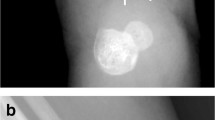Summary
Perinatal traumatic epiphysiolysis of the head of femur and humerus could be proved twice. In the other 5 cases treatment starts later. The diagnosis of this 5 cases was not sure, because only early diagnosis with proof of a dislocated diaphysis and building of a callus coat gives evidence of epiphysiolysis. Later symptoms are the roaftop metaphysis and enlargement of the trochanter minor or the medical humerus metaphysis. Most important complication is blocking of part of the epiphyseal line with forced deformity on neck and head of femur and humerus. It is of interest to discuss the primary necrosis of the epiphysis after perinatal traumatic epiphysiolysis.
Résumé
Des détachements d'épiphyse périnatales traumatiques sur le bout proximale de femure et d'humerus étaient démontés 2fois et pouvaient été fait probable 3fois. 2fois le cours et la déformation posterieure indiquent un détachement d'épiphyse perinatale. Seulement le diagnostic de bonne heure avec la preuve de la dislocation du diaphyse et du manteau de callus preuvent le détachement d'épiphyse. Des symptômes posterieures sont le métaphyse de la crête et l'agrandissement du trochanter minor respectivement du métaphyse mediale d'humerus. La complication la plus importante est la barrière en partie du joint d'èpiphyse avec une déformation forcée au cou et à la tête du femure et d'humerus. Il faut aussi discuté la nècrose d'épiphyse primaire après le détachement d'épiphyse périnatale traumatique.
Zusammenfassung
Perinatale traumatische Epiphysenablösungen am proximalen Femurund Humerusende konnten 2mal bewiesen und 3mal wahrscheinlich gemacht werden. 2mal sprechen Verlauf und spätere Deformierung für eine perinatale Epiphysenablösung. Nur die Frühdiagnose mit Nachweis der Dislokation der Diaphyse und des Callusmantels beweist die Epiphysenablösung. Spätere Symptome sind die Dachfirstmetaphyse und die Vergrößerung des Trochanter minor bzw. der medialen Humerusmetaphyse. Wichtigste Komplikation ist die Teilverblockung der Epiphysenfuge mit Zwangsdeformierung an Hals und Kopf von Femur und Humerus. Auch die primäre Epiphysennekrose nach perinataler traumatischer Epiphysenablösung ist zu diskutieren.
Similar content being viewed by others
Literatur
Gaugele, K.: Über die sogenannte Entbindungslähmung des Armes. Z. orthop. Chir. 34, 511–527 (1914).
Harrenstein, R. J.: Pseudoluxatio coxae durch Abreißen der Femurepiphyse bei der Geburt. Bruns Beitr. klin. Chir. 146, 592–604 (1929).
Holland, C.: Beitrag zur Dysplasie des Schultergelenks (unter besonderer Berücksichtigung des Humerus varus). Z. Orthop. 100, 31–38 (1965).
Jorge, J. M.: Traitement des épiphysiolyses obstétricales de l'humerus. Rev. Orthop. 13, 193–198 (1927).
Lucas, L. S., and J. H. Gill: Humerus varus following birth injury to the proximal humeral epiphysis. J. Bone Jt Surg. 29, 367–369 (1947).
Matthäus, H.: Schwierigkeiten in Diagnostik und Therapie der traumatischen Epiphysenlösung der Neugeborenen. Z. Orthop. 104, 273–276 (1968).
Mau, C.: Die röntgenologischen Veränderungen bei der angeborenen Schulterlähmung unter besonderer Berücksichtigung der sogenannten Lateralverschiebung der oberen Humerusepiphyse. Fortschr. Röntgenstr. 31 I, 212–218 (1923).
Mortens, J., and P. Christensen: Traumatic separation of the upper femoral epiphysis as an obstetrical lesion. Acta orthop. scand. 34, 239–250 (1964).
Otte, P.: Das Wesen der Perthes'schen Erkrankung unter besonderer Berücksichtigung der Pathogenese und des röntgenologischen Bildes. Verh. dtsch. orthop. Ges. 54, 140–158 (1968).
Parrot: Union medicale, Janvier 1870. Zit. n. Niederecker: Handbuch der Orthopädie, Bd. III, S. 138. Stuttgart: Georg Thieme 1959.
Pfeiffer, R.: Die geburtstraumatische Epiphysenlösung am proximalen Femurende. Z. orthop. Chir. 72, 256–257 (1941).
Pforte: Zwei seltene bei der Extraktion entstandene Verletzungen. Gynäkol. Rundschau 8 II, 285–289 (1908).
Pitzen, P.: Über die sogenannte Entbindungslähmung des Armes. Z. orthop. Chir. 43, 230–247 (1924).
Scaglietti, O.: The obstetrical shoulder trauma. Surg. Gynec. Obstet. 66, 868–877 (1938).
Seeligmüller, A.: Über Lähmungen, welche Kinder intra partum acquirieren. Berl. klin. Wschr. 40, 500–503 (1874).
Steinert, V.: Epiphysenlösungen und Epiphysenfrakturen. Arch. orthop. Unfall-Chir. 58, 200–220 (1965).
Valentin, B.: Zur Kenntnis der Geburtslähmung (Duchenne-Erb) und der dabei beobachteten Knochenaffektionen. Arch. orthop. Unfall-Chir. 19, 111–156 (1921).
Author information
Authors and Affiliations
Rights and permissions
About this article
Cite this article
Henssge, J., Böckmann, H. Perinatale traumatische Epiphysenablösung am Humerus- und Femurkopf. Arch orthop Unfall-Chir 66, 114–126 (1969). https://doi.org/10.1007/BF00417244
Received:
Issue Date:
DOI: https://doi.org/10.1007/BF00417244




